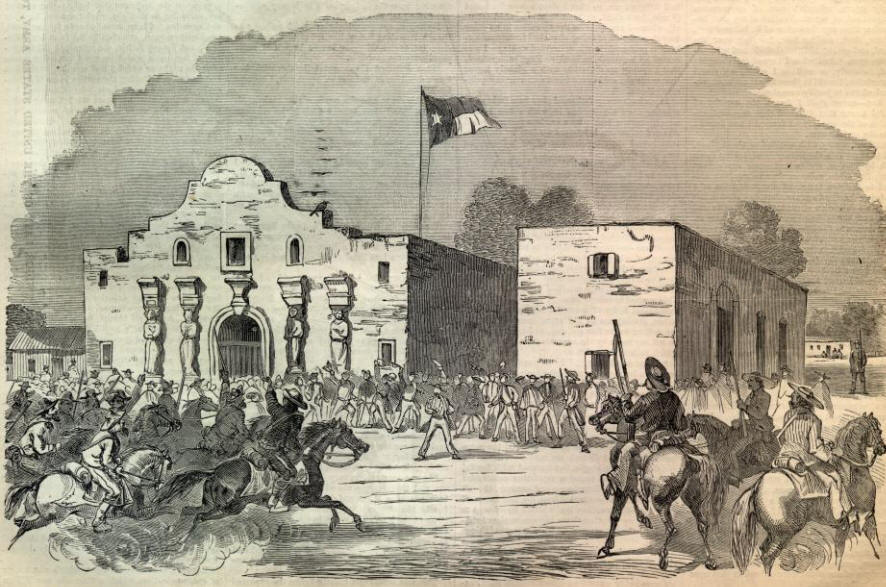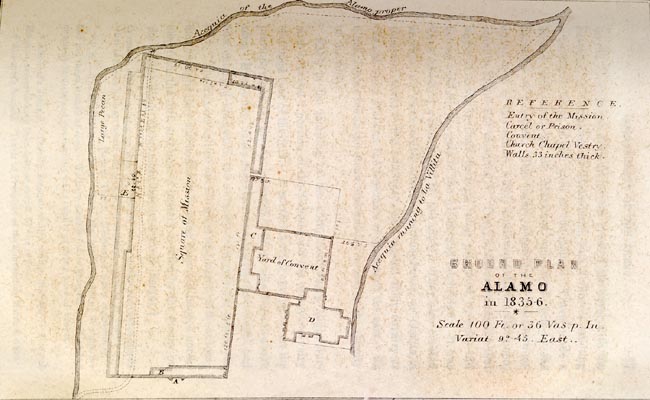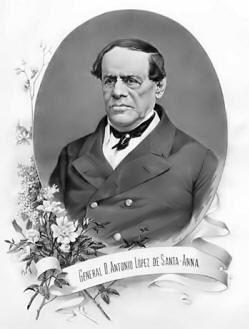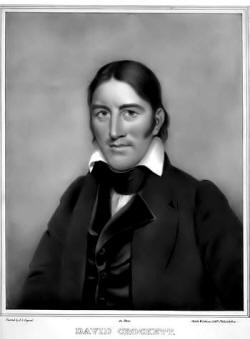Battle of the Alamo
![]()
This Site:
The AlamoTexan forces captured San Antonio and the Alamo on December 10, 1835. At this point, Santa Anna and his entire army began their March to Texas. Santa Anna reached the Alazan at noon, on the 23d day of February, 1836 ; and Urrea arrived at San Patricio before dawn on the morning of the 27th. At two o'clock in the afternoon, Santa Anna marched into San Antonio: The Texan guard in the town retired in good order to the Alamo. Colonel Travis, in anticipation of an attack, had done what he could to strengthen the walls, and provide means for defense. The Alamo, though strong, was built for a mission, and not for a fortress. The walls are thick, but of plain stone-work, and without a redoubt or bastion to command the lines of the fort. The main wall is a rectangle, one hundred and ninety feet long, and one hundred and twenty-two feet wide. On the southeast corner was attached the old church, a large building, and containing the magazine and soldiers' quarters. Adjoining this on the east side was the stone cuartel for horses. About midway of the east side of the main wall, but within it, was a two-story stone building; the upper story being used for a hospital, and the lower one for an armory, soldiers' quarters, &c. There were four pieces of artillery mounted on the side toward the town, and a like number facing the north; two on the side of the church, and four to defend the gate which looked toward the bridge across the San Antonio river. The place was supplied with water from two aqueducts running on either side of the walls. But Travis was greatly deficient in men, provisions, and ammunition. Original 1856 Map of the AlamoSanta Anna immediately demanded a surrender of the Alamo and its defenders, without terms. The demand was answered by a shot from the fort. The enemy then hoisted a blood-red flag in the town, and commenced an attack. It was intended to be by slow approaches, for at first the bombardment was harmless. Travis sent off an express with a strong appeal for aid, declaring that he would never retreat. COMMANDANCY OF THE ALAMO, BEXAR, February 24, 1836.
FELLOW-CITIZENS AND COMPATRIOTS : I am besieged by a
thousand or more of the Mexicans under Santa Anna. I have sustained a
continued bombardment for twenty-four hours, and have not lost a man.
The enemy have demanded a surrender at discretion ; otherwise the
garrison is to be put to the sword, if the place is taken. I have
answered the summons with a cannon-shot, and our flag still waves
proudly from the walls. I shall never surrender or retreat. Then I call
on you in the name of liberty, of patriotism, and of everything dear to
the American character, to come to our aid with all despatch. The enemy
are receiving reinforcements daily, and will no doubt increase to three
or four thousand in four or five days. Though this call may be
neglected, I am determined to sustain myself as long as possible, and
die like a soldier who never forgets what is due to his own honor and
that of his country. Victory or death! Early on the 25th, Santa Anna in person crossed the river with the battalion de Cazadores of Matamoras, with a view of erecting a battery in front of the gate of the Alamo. Travis made a strong resistance, and the Mexicans were reinforced by the battalion of Ximines. The enemy, according to their own account, lost in this action, which continued until the afternoon, eight in killed and wounded. They, however, succeeded that night in erecting their battery, being protected by some old houses between the gate of the Alamo and the bridge. It was three hundred yards south of the place. They also erected another, the same night, near the powder-house, or Garita, a thousand yards to the southeast ; and posted their cavalry at the old Casa Mata on the Gonzales road, toward the east. At night, Travis burnt the straw and wooden houses in the vicinity of the fort. Early in the morning of the 26th, there was a slight skirmish between a portion of the Texans and the enemy's cavalry stationed east of the fort. A norther having sprung up on the previous night, the thermometer fell to thirty-nine degrees above zero. Meanwhile, Santa Anna had received reinforcements, and now enlarged his guard, the sentinels being placed nearer the fort. The Texans sallied out for wood and water, without loss ; and at night they succeeded in burning some old houses northeast from the fort, and near a battery erected by the enemy on the Alamo ditch, about eight hundred yards distant. During all this time the Mexicans kept up a constant firing, but with little effect. On the 28th, they erected another battery at the old mill, eight hundred yards north, and attempted to cut off the water from the fort. The Texans were engaged in strengthening their works, by throwing up earth on the inside of the walls. It is proper here to state that Travis wrote on the 23d to Colonel Fannin, then at Goliad, making known his position, and requesting him to march to his relief. The letter reached Goliad on the 25th. Fannin set out on his march for Bexar on the 28th, with three hundred men and four pieces of artillery, leaving Captain Westover in command at Goliad, with about a hundred men. But he had only proceeded two hundred yards, when one of his wagons broke. down, and, having but one yoke of oxen to each piece of artillery, he was compelled to double his teams in order to get them, one at a time, across the river. Besides, his only provisions consisted of a tierce of rice and a little dried beef. A council of war was therefore held, when it was determined to return to Goliad, which was accordingly done. The intelligence of Fannin's departure for Bexar was received by the enemy at the latter place the same day on which he started ; and, before the council of war, above alluded to, was closed, on the 29th, General Sesma, with detachments of cavalry and infantry, was on his march to meet him. On the morning of the 1st of March, thirty-two gallant men from Gonzales were safely conducted by Captain John W. Smith into the Alamo, making the effective force under Travis one hundred and eighty-eight men. The bombardment of the fort still continued. The Texans, being short of ammunition, fired but seldom. In the evening, however, they struck the house occupied by Santa Anna in Bexar with a twelve-pound shot. On the 2d, the attack was still maintained. The Texans continued the fight as their means and strength would allow. On the 3d, the enemy erected a battery on the north of the fort, and within musket-shot. Travis addressed a last appeal to the president of the convention, setting forth fully his position and determination. He stated that the " blood-red banners which waved on the church at Bexar, and in the camp above him, were tokens that the war was one of vengeance against rebels." Perhaps by the same courier he sent the affecting note to his friend in Washington county : " Take care of my little boy. If the country should be saved, I may make him a splendid fortune ; but if the country should be lost, and I should perish, he will have nothing but the proud recollection that he is the son of a man who died for his country." On that day, J. B. Bonham, who had gone as express to Fannin for aid, returned and made his way safely into the fort at eleven o'clock in the morning. At night the Texans made a sally, and had a skirmish with the Mexican advance. * In a letter of Travis, dated the 3d of March, and furnished by Jesse Grimes, Esq., he says: "I am still here, in fine spirits, and well to do. With one hundred and forty-five men, I have held this place ten days against a force variously estimated from fifteen hundred to six thousand; and I shall continue to hold it till I get relief from my countrymen, or I will perish in its defence. We have had a shower of bombs and cannon-balls continually falling among us the whole time, yet none of us have fallen. We have been miraculously preserved."
On Sunday morning, the 6th of March, a little after midnight, the Alamo
was surrounded by the entire Mexican army. The cavalry were placed
without the infantry, to cut them down if they offered to give way. The
latter were provided with scaling-ladders. The enemy, thus forming a
circle facing the fort, advanced rapidly under a tremendous fire from
the Texan rifles and artillery. Just at daylight the ladders were placed
against the walls, and an attempt made by the enemy to enter the fort,
but they were driven back by the stern defenders within. Again the
charge was sounded, and a second effort made to reach the top of the
walls, but again the assailants were repulsed. For a few minutes there
was a pause. By the presence, threats, and promises, of Santa Anna, a
third assault was made, and with more fatal success. The enemy, reaching
the tops of the ladders, wavered and fell ; but their places were
supplied by the Thus fell the Alamo and its heroic defenders ; but before them lay the bodies of five hundred and twenty-one of the enemy, with a like number wounded. At an hour by sun, on that Sabbath morning, all was still ; yet the crimson waters of the aqueduct around the fort resembled the red flag on the church at Bexar! The defenders of Texas did not retreat, but lay there in obedience to the command of their country; and in that obedience the world has witnessed among men no greater moral sublimity. Those in the fort that survived were, Mrs. Dickinson (wife of Lieutenant Dickinson, who fell in the defense), her child, a negro-servant of Colonel Travis, and two Mexican women of Bexar. The bodies of the Texans, after being stripped and subjected to brutal indignities, were thrown into heaps and burnt ! The most of them were Americans, many of them colonists, who emigrated to Texas under the assurance of the colonization laws that their rights and liberties should be protected. The Mexicans in Bexar were mostly hostile: only three of them were among the defenders of the Alamo. The enemy's victory was complete, yet his force was as sixteen to one, and his loss in slain nearly three times the entire number of the defenders. From the known character of Santa Anna, he doubtless rejoiced. Believing the war at an end, and Texas at his feet, he so announced it in his dispatches to his subordinates at home. And the authorities and people there believed it, and so congratulated him. " With pleasure do I sincerely congratulate your Excellency," observes Jose M. Ortis Monasterio, secretary of state, in a letter from Mexico, dated the 22d of March, " for the brilliant triumph achieved over the perfidious colonists by the national arms under your command. This terrible lesson will be to us fruitful in prosperous results; besides, it will teach the sympathizers among our evil-disposed neighbors not to contend against your military talents, and the valor and decision of the brave soldiers who have covered themselves with honor in an assault so heroic. Providence is propitious to us, and has destined your Excellency to be the savior and preserver of the republic. Glorious with these titles, and ever patriotic, your Excellency has garnished your temples with laurels of unwithering fame." * Almonte, only three days before the storming of the Alamo, viewed the Mexican success there as effectually ending the war; for, in his journal of the 3d of March, he says he wrote to Mexico, directing his letters to be sent to Bexar, and that before three months the campaign would be terminated." [See Next: Goliad Massacre] * This was one of the letters afterward taken from the courier by Deaf Smith, and the "savior and preserver of the republic" never had the pleasure of reading it |
![]()
|
Site Copyright © 2003-2018 Son of the South. For questions or comments, contact paul@sonofthesouth.net. |
|
|
|
Are you Scared and Confused? Click Here to read My Snake Story, a story of hope and encouragement, to help you face your fears. |
||



